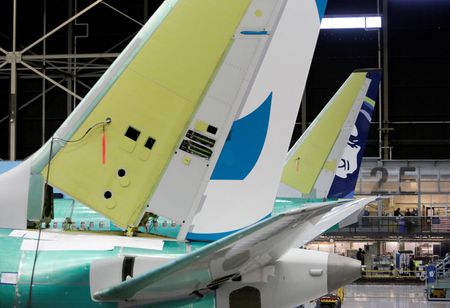By Tim Hepher and Padraic Halpin
DUBLIN (Reuters) – One of the aircraft industry’s most influential leaders believes Boeing will face a heavier regulatory backlash if there are further production snags such as the one suspected of causing a door plug blowout on an Alaska Airlines 737 MAX 9 jet.
If there is one more significant problem “the FAA will stop (737) production”, Air Lease Corp Executive Chairman Steven Udvar-Hazy told reporters at the Airline Economics conference in Dublin on Monday, referring to the U.S. Federal Aviation Administration (FAA).
However, he played down concerns of a systemic problem, saying the incident was contained to the Renton plant outside Seattle where the plane was assembled.
The FAA and Boeing were not immediately available for comment.
Investigators are probing whether bolts were missing or wrongly fitted when the airplane was delivered just eight weeks before the Jan. 5 blowout that led to a partial grounding.
The FAA last week took the unusual step of capping Boeing 737 production at current levels.
Answering questions at the conference, Udvar-Hazy, one of the founders of a booming aviation finance industry, called on Boeing to display its once-vaunted leadership in aircraft design but stopped short of calling for management changes.
“I think where the Boeing board and Boeing management has not paid enough attention to is where do we go from here, what is the next generation of airplane? What will Boeing be able to produce that will be a step-change improvement in operating economics to what they have today,” he said.
“So in that respect, I fault Boeing. As far as fixing their problems, there’s enough written in the media; I don’t have to really comment on that.”
Udvar-Hazy recalled that the MAX had originally been launched in 2011 as a reaction to the Airbus A320neo – itself triggered by an ultimately fruitless attempt by Canada to enter the market.
Both the MAX and the A320neo are upgrades featuring more efficient new engines attached to an existing airframe, with the underlying 737 design stretching back to the 1960s.
Boeing had been pondering an all-new jet when Airbus – unable at the time to afford an all-new single-aisle jet as it wrestled with its larger A380 superjumbo – deliberately forced its rival’s hand by landing a huge A320neo order, insiders say.
The duo compete for sales but for years have moved roughly in step with each other in a series of counter-reactions without spending the $15 billion needed to develop a single-aisle jet. Both have conceded a new plane is now unlikely before the 2030s.
Udvar-Hazy was credited with forcing Airbus to tear up its plans for a modest upgrade in the market for larger jets, and instead develop the new A350 in response to Boeing’s 787s.
But the leasing veteran said disruption left by the pandemic meant the supply chain could not deal with a new design for now.
He called on planemakers to stabilise factories before pushing too hard to increase production to meet rising demand.
Manufacturers, engine makers and suppliers face “tremendous challenges,” he said.
“By way of example, we have a 787-10 that’s going to hopefully deliver in May and it was supposed to deliver in the spring of 2020, so it’s going to be four years old. We have many 737s and Airbus single-aisle aircraft that are a year late, nine months late, eight months late. That’s more the norm today.”
He cast doubt on Airbus plans to raise core single-aisle production to 75 a month in 2026 and said the new A321XLR model, which is part of the plan, would be 16-18 months late.
Airbus declined to comment ahead of its results on Feb 15.
(Reporting by Tim Hepher and Padraic Halpin; Editing by David Goodman and Mark Potter)

